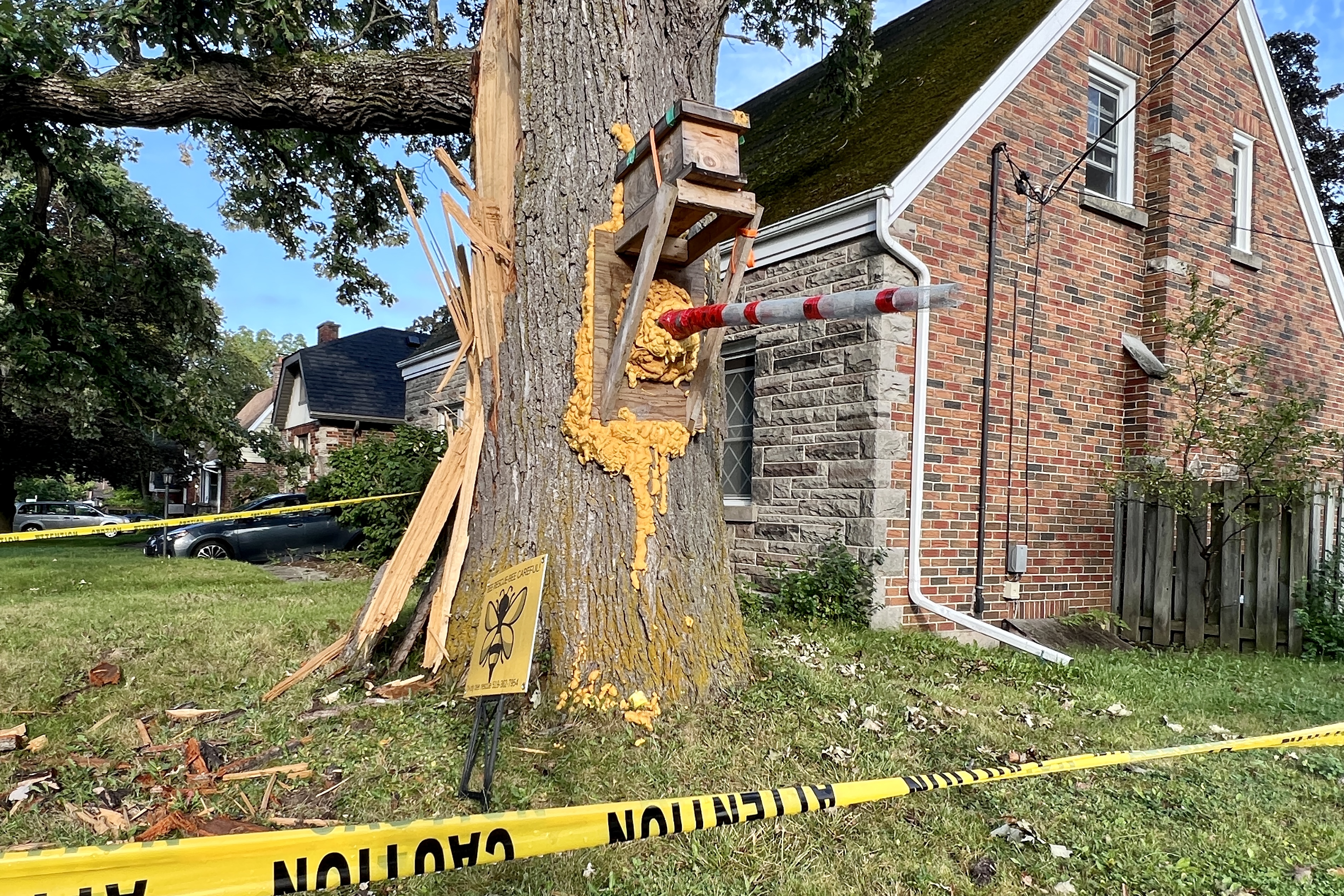Professional beekeepers are winning a weeks-long war to remove a massive colony of bees from a Cambridge tree but won’t declare victory until the queen is evicted from her throne of combs.
Members of the Tri-City Bee Rescue team have been working to outsmart and rehome more than 70,000 honey bees that set up shop in a massive tree at the corner of Main Street and Briercrest Avenue.
So far, they’ve vacuumed up more than 50,000 bees using a specialized device to safely capture and relocate bees to a quarantine compound, but they’re still trying to catch the queen in hopes of keeping the hive’s hierarchy intact.
More than six weeks ago, Cambridge officials contacted the rescue group after a city street cleaner was repeatedly stung while investigating the buzzing hive. The bees, excited by the sound of his vehicle and his close proximity, let the employee know who’s boss.
“They came out and showed him the business end of the bee,” said Tri-City’s Mike Barber.
After visiting the site the bee rescue team assessed the hive, determining it presented a safety risk to the public. Its location, adjacent to the sidewalk on a busy street, and the sheer size of the colony make for agitated, grumpy bees.
“This was a really big colony and they became annoyed with people walking by them all the time,” explained Barber.
The team got to work creating a decoy entrance and box hive to trick the worker forager bees from re-entering the tree.
They used a “ridiculous amount of spray foam” to block the entrance to the tree and a long funnel which served as a one-way door to the wooden box filled with the attractive smells of honey.
The bees turned out to be nimble than expected, putting their collective instincts to work. Using their GPS they figured out how to get back through their original entrance and into the tree.
“They got smart, but they are also very industrious,” said Barber, “so they would chew the foam, they would hang out at the end of the funnel and actually let their sisters know the entrance was over there, which we caught them doing a couple times.”
The team had to return repeatedly to modify the contraption, making the funnel longer with each visit, creating a spectacle at the busy street corner. In addition to the tree being covered in spray foam, the team cordoned off the sidewalk’s corner with caution tape to reduce risks for curious observers.
Attempting to trap and move the bees was a little concerning for the beekeepers, who know all too well that forager bees, the oldest and most defensive and grumpy of the bees, become even more menacing when they can’t get home.
“If you were locked out of your house when you came home you wouldn’t be happy about it. And neither are they.”
This continuous “trap-out” battle waged for weeks but the bee rescuers proved to be more clever and more patient than the anxious bees.
“It was a game of cat and mouse, beekeeper and bee, however you want to say it,” laughed Barber. “They were definitely winning some of the battles but I think we’ve finally won the war. They’re pretty much out of the tree.”
Except for the queen, that is. The queen bee, explained Barber, often takes the longest to relocate because she never leaves the hive.

“Basically we’re trying to trick her,” he said. “If all her daughters don’t come home she’ll eventually not have enough bees in the hive to take care of her because she’s a queen … she doesn’t do stuff on her own.”
With some time, her ovaries will shrink and she’ll be able to fly and hopefully find her way to the decoy box hive attached to the tree, only to realize everyone’s moved out without telling her.
Barber noted the team checks for her frequently and hopes to be able to get her back to her colony in their new quarantine where they’re monitored for diseases and viruses and encouraged to form their own new hive.
Until the bee colony relocation effort is complete Barber recommends passersby steer clear of the tree, noting that bees are reactive and will become aggressive if agitated.
“Definitely give them their space” he said. “I mean they are stinging insects. They don’t like to sting because they will die when they sting. But they’re selfless so they don’t mind dying for their sisters and their momma.”
An arborist is expected to assess the health of the Briercrest tree, which could be compromised after a large branch broke off during a recent storm. Plans to save the tree could involve filling it with an environmentally safe foam “glue” to keep it intact.


